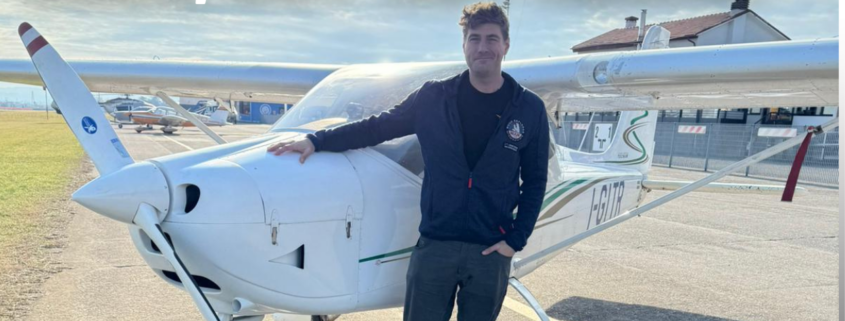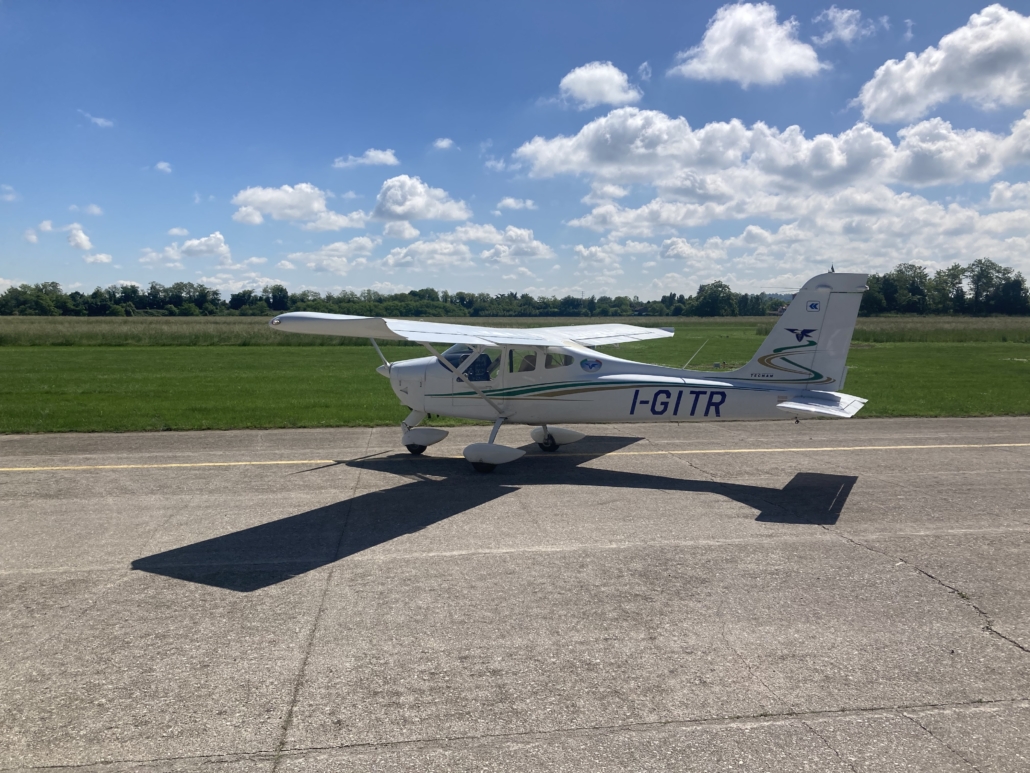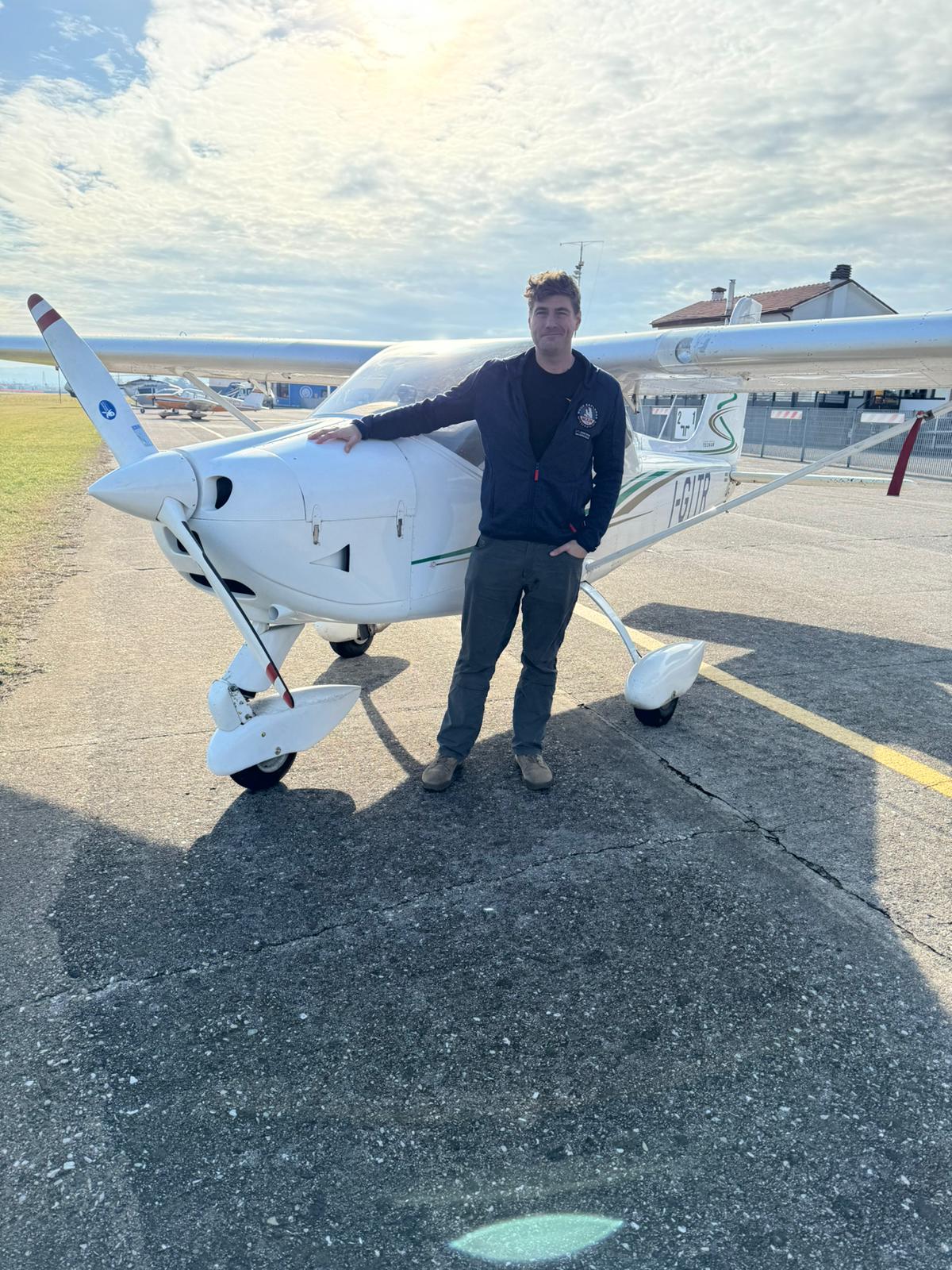|
Getting your Trinity Audio player ready...
|
Giorgio’s voice came over the radio: “Nick, can you hear me? Check. Check.”
I sat in the cockpit of the old Tecnam P92-JS Echo, tail number I-GITR. The plane was one of the earliest of its model built by Tecnam, and the tail number was an homage to former Italian finance minister Giulio Tremonti. I replied, “I hear you loud and clear, Giorgio—can you hear me?”
Silence.
Giorgio tried again: “Nick? Nick? Can you hear me?”
Again, I responded. Again, no reply.
I was a bit nervous now, unsure what was wrong. It was noon on a clear, cold January day, and I was taxiing to the start of the grass runway at little Thiene Airport for my first solo flight. I slid my feet up on the pedals to brake and came to a halt. The snowy Dolomites loomed in the distance, stunning as ever—but already things were off to a rocky start.
I was just shy of 13 flight hours toward earning my EASA Private Pilot License in Italy. I’d been stationed with the U.S. Army here for five years, but my flight training had been sporadic and interrupted since I began in May 2023. A mix of military duties and life-altering circumstances—including a difficult custody battle for my five-year-old son—had made it tough to maintain consistency. But that very struggle is what pushed me, at 37 years old, to finally pursue this dream.
I’ve been in the Army in some capacity my entire adult life, with the exception of two years in college, law school, and nine months interning at law firms in Germany. As an Army officer—not Air Force—I was never deeply exposed to aviation. I’d ridden in helicopters, C-130s, and even a white, unmarked Air Force jet outfitted with school bus seats and no toilet during various deployments. I’d served as the legal advisor in targeting cells that put “warheads on foreheads” in Syria during the fight against ISIS—but we were always the “ground customers,” waiting for the right platform to deliver the payload. I had posed for the obligatory “cool-guy” photos in front of B-1 bombers at Al Udeid Air Base in Qatar, but I wasn’t an aviator.
Still, the seed had been planted early—by, of all things, an MS-DOS video game called Aces Over the Pacific. I was 10 years old, and my grandfather, a former Air Force pilot, watched me play and gave me tips that actually worked. From then on, the itch to fly never quite went away.
One sleepless night, while worrying about my son, leaving the Army, and the idea of building a new life in Italy, a thought surfaced: Pilot license. Why wait until things are less crazy? You might be here forever. If not now, when?
By sunrise, I was online researching local flight schools. I emailed six in northern Italy and was pleasantly surprised to find all of them within driving distance. But there was one significant obstacle—the language barrier.
Despite five years in Italy, I still struggled with Italian. Working on base every day in English didn’t help, and I had only learned enough to navigate restaurants, shopping, and housing issues. Of the six schools I contacted, five replied. One replied in English and said we could start immediately. That school, Aeroclub A. Ferrarin in Thiene, became my new aviation home.
Moments before my Dolomite-facing runway pause, Giorgio and I had flown several circuits around the traffic pattern. After landing, he turned to me and said, “OK, Nick, you are hereby ready to fly solo. Remember, the plane will be much lighter without me. Also, the ground is wet—don’t use brakes when you land.”
I knew this milestone was approaching. We had practiced tacchi a terra (heels down on the pedals), ascents, descents, turns, volo lento (slow flight), stalls, and landing with engine and flap failures. I had memorized the Thiene traffic pattern: which altitudes to hit at each landmark, when to make the calls, when to enter slow flight, and where to drop full flaps on final.
Giorgio hopped out and walked back to the Aeroclub’s office to get on the radio. I taxied alone to the threshold of runway 17.
Thiene Airport traces its roots to the First World War and is named after Italian ace Arturo Ferrarin. It sits just before the start of the Dolomites—my favorite part of the Alps. Circling the single grass runway offers views of the Asiago Plateau, namesake of the cheese and battlefield where a young Ernest Hemingway served as an ambulance driver. It’s hard to focus on flying with so much beauty around you. On clear days you can see the twin castles of “Romeo and Juliet” near Verona and the military bases where I spend most of my days.
In Italian, “solo” means “alone” or “only.” Sitting on the runway with an empty right seat and failed radio contact, I felt very much solo. I keyed the mic again, then realized—I hadn’t been pressing the push-to-talk button. I’d become so used to Giorgio next to me that I was just speaking into my headset. Great way to start.
I pressed the button and said, “Ciao Giorgio, I hear you now. Can you hear me?”
“Yes,” came the reply. “Loud and clear, Nick.”
I lined up on the runway with renewed confidence, still rattled by the basic mistake. But there was no turning back now.
Throttle full open. At 55 knots, I eased back on the stick. The I-GITR lifted off and I was flying solo for the first time. I glanced at the empty right seat, then at the tiny air traffic control tower. There’s no going back. You’re airborne. Nobody’s landing this plane but you.
I climbed quickly—Giorgio was right. The plane was much lighter. I passed 800 feet—fuel pump off, landing light off, flaps up. At 900 feet, I turned left to stay in the pattern, climbing to 1300 feet. On left downwind for Runway 17, I made the proper radio call.
Preparing for volo lento, I reduced power and eased into a nose-up attitude—but I rushed it. The little Tecnam was feather-light now, and I drifted up to 1500 feet. I panicked briefly. Too high!
The Army gave me two useful sayings: “Trust in your equipment and your training,” and “Slow is smooth, and smooth is fast.” I believed in the Tecnam and my training—but I really needed the second saying now. I took a breath and slowed everything down.
I also remembered: Giorgio and I had practiced landing with no flaps and no engine. If we could do that, I’d be fine. I looked left toward the runway and saw Monte Summano’s double-humped summit—my favorite landmark. My partner Valentina and I had hiked it together exactly one year before.
I wasn’t completely solo anymore.
I rounded the northern corner of the pattern and lined up for final. Full flaps down. I checked the altimeter less and flew by feel, using the familiar trees and rooftops to judge altitude. I noticed I was a little low. I nudged the throttle to give myself a boost over the last tree line. A crosswind gust nudged me left; I corrected with right rudder. Giorgio had been right again—the soggy Venetian soil absorbed my landing like a pillow. I rolled to a stop, no brakes needed.
“Congratulations,” Giorgio said over the radio. “You just completed your first solo!”
I’ve loved my aviation journey so far. It has been deeply therapeutic during a challenging time and will remain a healthy outlet for years to come. Flying demands a unique mix of skills—and a balance of teamwork and self-reliance. That mix makes it an especially powerful experience for veterans or anyone navigating adversity.
Aviation teaches you that you’re never truly solo—not in the cockpit and not in life. There’s always a lesson, a memory, a landmark, or a voice on the radio to help you when you need it.
Just don’t forget to press the push-to-talk button.
- Solo, But Not Alone - August 1, 2025







How delightful, thank you for sharing this story. Please keep writing about flight. Tucking that one away: solo but not alone.
Wow, that ending gave me chills. As a newly-minted private pilot who is still scared of flying solo, I will think of this often. Thanks for the story!